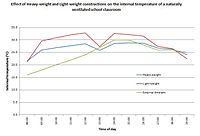
Photo from wikipedia
School-age children are particularly prone to disturbances in body composition, because this is a period of intensive growth and a period in which correct habits are shaped, especially in relation… Click to show full abstract
School-age children are particularly prone to disturbances in body composition, because this is a period of intensive growth and a period in which correct habits are shaped, especially in relation to diet. This is why it is so important to diagnose emerging disorders early so as to implement therapeutic or educational activities. The aim of this study was to assess the relationship between the factors of body mass composition and body mass index (BMI), as well as the balance parameters in children and adolescents. The study group consisted of 1137 children aged 7 to 15. There were 559 girls and 578 boys among the subjects. The study used the Tanita 780 body mass composition analyser and the Zebris stabilometric platform. It was found that girls were characterized by a significantly higher content of adipose tissue (24.37% vs. 20.45%), while boys were characterized by a higher content of lean tissue (32.99% vs. 30.43%), muscle tissue (31.23% vs. 28.86%) and water (24.15% vs. 22.28%). Interestingly, the girls had better balance than their peers in all analyzed parameters (COF TTL.—616.72 vs. 661.50; CEArea—73.63 vs. 112.24; COF HD—3.44 vs. 4.23; COF VD—4.52 vs. 5.12). It turned out that among children in adolescence, a higher adipose tissue content and a higher BMI correlated with a smaller surface area (p < 0.05) defined by the center of gravity and smaller deviations of the center of gravity in the horizontal plane (p < 0.05). Sex and adolescence play an important role in differentiating both body composition and body balance. The results of this study allow us to conclude that children with higher BMI values have better balance. Due to the fact that these conclusions are inconsistent with those of other researchers, it will be worth continuing the research (e.g., on a different population group) in order to confirm the results and to draw far-reaching conclusions.
Journal Title: International Journal of Environmental Research and Public Health
Year Published: 2021
Link to full text (if available)
Share on Social Media: Sign Up to like & get
recommendations!